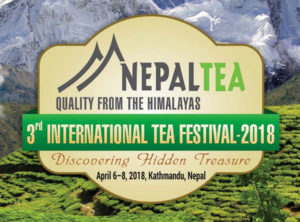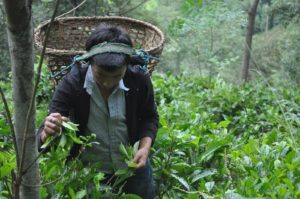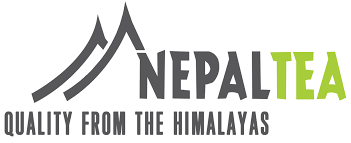KATHMANDU, Nepal
 Nepal signed several national initiatives last week that will further open the landlocked nation to trade. These include a new rail line linking Kathmandu to India, opening inland waterways essential to moving bulk products, and normalizing cross-border commerce.
The third Nepal International Tea Festival concluded Sunday with a boost in momentum for the tea trade, an export subsector growing in importance. Fifteen years ago, Nepal produced 5 million kilos of tea. In 2017, production exceeded 24 million kilos, doubling in the past 10 years and expanding the orthodox category of high-value tea to 5.5 million kilos. Virtually all the orthodox tea is exported to Europe, the United States, Asia, and Russia. Another 18.5 million kilos of crush-tea-curl tea, grown in the lower Terai, is shipped to India. Exports were virtually nil in the year 2000 and are now valued at $23.2 million.
“Enhanced connectivity will definitely contribute to our desire to be a land-linked country instead of land-locked,” Nepal Prime Minister K.P. Sharma Oli said in Delhi following talks with Indian Prime Minister Narendra Modi. In 2015, following a political dispute, India blocked trade routes, a move that halted tea shipments for many months and took place during Mr. Oli’s last tenure as prime minister. The move led Nepal to negotiate a rail line leading to China.
The three-day event, hosted by the Nepal Tea and Coffee Development Board (NTCDB) attracted tea buyers, exporters, and growers as well as representatives of the specialty tea and marketing associations. Chakra Pani Khanal, minister for Agriculture, Land Management and Cooperative inaugurated the event. Speakers included Deepak Khanal, director of the NTCDB and Chandra Bhushan Subba, CEO of the Himalayan Orthodox Tea Producers Associaiton. Prabhat Kamal Bezboruah, chairman of the Tea Board of India who was best remembered for his assertion that it is “baseless” to call the best teas of Nepal inferior to Darjeeling, was a special guest.
Nepal signed several national initiatives last week that will further open the landlocked nation to trade. These include a new rail line linking Kathmandu to India, opening inland waterways essential to moving bulk products, and normalizing cross-border commerce.
The third Nepal International Tea Festival concluded Sunday with a boost in momentum for the tea trade, an export subsector growing in importance. Fifteen years ago, Nepal produced 5 million kilos of tea. In 2017, production exceeded 24 million kilos, doubling in the past 10 years and expanding the orthodox category of high-value tea to 5.5 million kilos. Virtually all the orthodox tea is exported to Europe, the United States, Asia, and Russia. Another 18.5 million kilos of crush-tea-curl tea, grown in the lower Terai, is shipped to India. Exports were virtually nil in the year 2000 and are now valued at $23.2 million.
“Enhanced connectivity will definitely contribute to our desire to be a land-linked country instead of land-locked,” Nepal Prime Minister K.P. Sharma Oli said in Delhi following talks with Indian Prime Minister Narendra Modi. In 2015, following a political dispute, India blocked trade routes, a move that halted tea shipments for many months and took place during Mr. Oli’s last tenure as prime minister. The move led Nepal to negotiate a rail line leading to China.
The three-day event, hosted by the Nepal Tea and Coffee Development Board (NTCDB) attracted tea buyers, exporters, and growers as well as representatives of the specialty tea and marketing associations. Chakra Pani Khanal, minister for Agriculture, Land Management and Cooperative inaugurated the event. Speakers included Deepak Khanal, director of the NTCDB and Chandra Bhushan Subba, CEO of the Himalayan Orthodox Tea Producers Associaiton. Prabhat Kamal Bezboruah, chairman of the Tea Board of India who was best remembered for his assertion that it is “baseless” to call the best teas of Nepal inferior to Darjeeling, was a special guest.
 “Nepal makes teas that are as good as the best Darjeelings; similar in character to Darjeeling, but subtly different,” said Bezboruah. “It is a shame that they had to clandestinely masquerade as Darjeeling tea to achieve a pricing premium,” he said. It would be a “win-win for Nepal as well as India (Darjeeling) if Nepal’s high grown teas were offered as such in Indian auctions.”
Bezboruah promised to review India’s auction rules “to see if there is a way to alter the regulations to permit this as it would break the back of the clandestine trade.”
The conference began with a tea tasting at the Mount Everest base camp on Friday, followed by a two-day conference, and continues this week with tours of gardens in the Ilam region. Attendees included tea professionals from Japan, China, Canada, Australia, France, Germany, Russia, and Denmark. Kathmandu is 275 kilometers distant from the fertile tea-growing center near Jhapa in eastern Nepal where most of the country’s 26,000 hectares of tea is planted.
Activities included the formal unveiling of the Nepal Tea trademark for orthodox tea. “We now export around half of the tea produced in the country, which has transformed Nepal into a tea-exporting country,” said Shesh Kant Gautam, executive director of the NTCDB. Exports are up by 26.5 percent in the first seven months of the current fiscal year, bringing sales of NPRs2.21 billion ($21.4 million), as reported in the Kathmandu Post.
Demand Increasing
Discovering the hidden treasure of Nepal was the conference theme, according to Udaya Chapagain, organizing committee coordinator. He called the event “an important step in promoting Nepal tea in the global market.” The consensus view is that poor marketing and a lack of commercialization has held back Nepali tea from becoming a competitive global brand, observed Agriculture Minister Chakrapani Khanal.
The trademark, which offers protection against adulteration and the dilution of Nepal’s artisan
“Nepal makes teas that are as good as the best Darjeelings; similar in character to Darjeeling, but subtly different,” said Bezboruah. “It is a shame that they had to clandestinely masquerade as Darjeeling tea to achieve a pricing premium,” he said. It would be a “win-win for Nepal as well as India (Darjeeling) if Nepal’s high grown teas were offered as such in Indian auctions.”
Bezboruah promised to review India’s auction rules “to see if there is a way to alter the regulations to permit this as it would break the back of the clandestine trade.”
The conference began with a tea tasting at the Mount Everest base camp on Friday, followed by a two-day conference, and continues this week with tours of gardens in the Ilam region. Attendees included tea professionals from Japan, China, Canada, Australia, France, Germany, Russia, and Denmark. Kathmandu is 275 kilometers distant from the fertile tea-growing center near Jhapa in eastern Nepal where most of the country’s 26,000 hectares of tea is planted.
Activities included the formal unveiling of the Nepal Tea trademark for orthodox tea. “We now export around half of the tea produced in the country, which has transformed Nepal into a tea-exporting country,” said Shesh Kant Gautam, executive director of the NTCDB. Exports are up by 26.5 percent in the first seven months of the current fiscal year, bringing sales of NPRs2.21 billion ($21.4 million), as reported in the Kathmandu Post.
Demand Increasing
Discovering the hidden treasure of Nepal was the conference theme, according to Udaya Chapagain, organizing committee coordinator. He called the event “an important step in promoting Nepal tea in the global market.” The consensus view is that poor marketing and a lack of commercialization has held back Nepali tea from becoming a competitive global brand, observed Agriculture Minister Chakrapani Khanal.
The trademark, which offers protection against adulteration and the dilution of Nepal’s artisan  teas, is an important step. “Demand is increasing,” said Chapagain. It will only appear on tea that has met international manufacturing standards.
“This event will help Nepali tea farmers and entrepreneurs gain market popularity and access,” said Gautam.
The country’s more than 21,000 smallholder tea farmers produce more than 80 percent of the orthodox green leaf. The industry employs another 60,000 Nepalese entrepreneurs to harvest, process, and distribute its tea.
Organizations supporting the event include the Himalayan Orthodox Tea Producer’s Association, Himalayan Tea Producers Cooperative, the Specialty Tea Association Nepal, Central Tea Cooperative Federation Nepal, and the Nepal Tea Planters Association.
Source: Kathmandu Post
teas, is an important step. “Demand is increasing,” said Chapagain. It will only appear on tea that has met international manufacturing standards.
“This event will help Nepali tea farmers and entrepreneurs gain market popularity and access,” said Gautam.
The country’s more than 21,000 smallholder tea farmers produce more than 80 percent of the orthodox green leaf. The industry employs another 60,000 Nepalese entrepreneurs to harvest, process, and distribute its tea.
Organizations supporting the event include the Himalayan Orthodox Tea Producer’s Association, Himalayan Tea Producers Cooperative, the Specialty Tea Association Nepal, Central Tea Cooperative Federation Nepal, and the Nepal Tea Planters Association.
Source: Kathmandu Post
 Nepal signed several national initiatives last week that will further open the landlocked nation to trade. These include a new rail line linking Kathmandu to India, opening inland waterways essential to moving bulk products, and normalizing cross-border commerce.
The third Nepal International Tea Festival concluded Sunday with a boost in momentum for the tea trade, an export subsector growing in importance. Fifteen years ago, Nepal produced 5 million kilos of tea. In 2017, production exceeded 24 million kilos, doubling in the past 10 years and expanding the orthodox category of high-value tea to 5.5 million kilos. Virtually all the orthodox tea is exported to Europe, the United States, Asia, and Russia. Another 18.5 million kilos of crush-tea-curl tea, grown in the lower Terai, is shipped to India. Exports were virtually nil in the year 2000 and are now valued at $23.2 million.
“Enhanced connectivity will definitely contribute to our desire to be a land-linked country instead of land-locked,” Nepal Prime Minister K.P. Sharma Oli said in Delhi following talks with Indian Prime Minister Narendra Modi. In 2015, following a political dispute, India blocked trade routes, a move that halted tea shipments for many months and took place during Mr. Oli’s last tenure as prime minister. The move led Nepal to negotiate a rail line leading to China.
The three-day event, hosted by the Nepal Tea and Coffee Development Board (NTCDB) attracted tea buyers, exporters, and growers as well as representatives of the specialty tea and marketing associations. Chakra Pani Khanal, minister for Agriculture, Land Management and Cooperative inaugurated the event. Speakers included Deepak Khanal, director of the NTCDB and Chandra Bhushan Subba, CEO of the Himalayan Orthodox Tea Producers Associaiton. Prabhat Kamal Bezboruah, chairman of the Tea Board of India who was best remembered for his assertion that it is “baseless” to call the best teas of Nepal inferior to Darjeeling, was a special guest.
Nepal signed several national initiatives last week that will further open the landlocked nation to trade. These include a new rail line linking Kathmandu to India, opening inland waterways essential to moving bulk products, and normalizing cross-border commerce.
The third Nepal International Tea Festival concluded Sunday with a boost in momentum for the tea trade, an export subsector growing in importance. Fifteen years ago, Nepal produced 5 million kilos of tea. In 2017, production exceeded 24 million kilos, doubling in the past 10 years and expanding the orthodox category of high-value tea to 5.5 million kilos. Virtually all the orthodox tea is exported to Europe, the United States, Asia, and Russia. Another 18.5 million kilos of crush-tea-curl tea, grown in the lower Terai, is shipped to India. Exports were virtually nil in the year 2000 and are now valued at $23.2 million.
“Enhanced connectivity will definitely contribute to our desire to be a land-linked country instead of land-locked,” Nepal Prime Minister K.P. Sharma Oli said in Delhi following talks with Indian Prime Minister Narendra Modi. In 2015, following a political dispute, India blocked trade routes, a move that halted tea shipments for many months and took place during Mr. Oli’s last tenure as prime minister. The move led Nepal to negotiate a rail line leading to China.
The three-day event, hosted by the Nepal Tea and Coffee Development Board (NTCDB) attracted tea buyers, exporters, and growers as well as representatives of the specialty tea and marketing associations. Chakra Pani Khanal, minister for Agriculture, Land Management and Cooperative inaugurated the event. Speakers included Deepak Khanal, director of the NTCDB and Chandra Bhushan Subba, CEO of the Himalayan Orthodox Tea Producers Associaiton. Prabhat Kamal Bezboruah, chairman of the Tea Board of India who was best remembered for his assertion that it is “baseless” to call the best teas of Nepal inferior to Darjeeling, was a special guest.
 “Nepal makes teas that are as good as the best Darjeelings; similar in character to Darjeeling, but subtly different,” said Bezboruah. “It is a shame that they had to clandestinely masquerade as Darjeeling tea to achieve a pricing premium,” he said. It would be a “win-win for Nepal as well as India (Darjeeling) if Nepal’s high grown teas were offered as such in Indian auctions.”
Bezboruah promised to review India’s auction rules “to see if there is a way to alter the regulations to permit this as it would break the back of the clandestine trade.”
The conference began with a tea tasting at the Mount Everest base camp on Friday, followed by a two-day conference, and continues this week with tours of gardens in the Ilam region. Attendees included tea professionals from Japan, China, Canada, Australia, France, Germany, Russia, and Denmark. Kathmandu is 275 kilometers distant from the fertile tea-growing center near Jhapa in eastern Nepal where most of the country’s 26,000 hectares of tea is planted.
Activities included the formal unveiling of the Nepal Tea trademark for orthodox tea. “We now export around half of the tea produced in the country, which has transformed Nepal into a tea-exporting country,” said Shesh Kant Gautam, executive director of the NTCDB. Exports are up by 26.5 percent in the first seven months of the current fiscal year, bringing sales of NPRs2.21 billion ($21.4 million), as reported in the Kathmandu Post.
Demand Increasing
Discovering the hidden treasure of Nepal was the conference theme, according to Udaya Chapagain, organizing committee coordinator. He called the event “an important step in promoting Nepal tea in the global market.” The consensus view is that poor marketing and a lack of commercialization has held back Nepali tea from becoming a competitive global brand, observed Agriculture Minister Chakrapani Khanal.
The trademark, which offers protection against adulteration and the dilution of Nepal’s artisan
“Nepal makes teas that are as good as the best Darjeelings; similar in character to Darjeeling, but subtly different,” said Bezboruah. “It is a shame that they had to clandestinely masquerade as Darjeeling tea to achieve a pricing premium,” he said. It would be a “win-win for Nepal as well as India (Darjeeling) if Nepal’s high grown teas were offered as such in Indian auctions.”
Bezboruah promised to review India’s auction rules “to see if there is a way to alter the regulations to permit this as it would break the back of the clandestine trade.”
The conference began with a tea tasting at the Mount Everest base camp on Friday, followed by a two-day conference, and continues this week with tours of gardens in the Ilam region. Attendees included tea professionals from Japan, China, Canada, Australia, France, Germany, Russia, and Denmark. Kathmandu is 275 kilometers distant from the fertile tea-growing center near Jhapa in eastern Nepal where most of the country’s 26,000 hectares of tea is planted.
Activities included the formal unveiling of the Nepal Tea trademark for orthodox tea. “We now export around half of the tea produced in the country, which has transformed Nepal into a tea-exporting country,” said Shesh Kant Gautam, executive director of the NTCDB. Exports are up by 26.5 percent in the first seven months of the current fiscal year, bringing sales of NPRs2.21 billion ($21.4 million), as reported in the Kathmandu Post.
Demand Increasing
Discovering the hidden treasure of Nepal was the conference theme, according to Udaya Chapagain, organizing committee coordinator. He called the event “an important step in promoting Nepal tea in the global market.” The consensus view is that poor marketing and a lack of commercialization has held back Nepali tea from becoming a competitive global brand, observed Agriculture Minister Chakrapani Khanal.
The trademark, which offers protection against adulteration and the dilution of Nepal’s artisan  teas, is an important step. “Demand is increasing,” said Chapagain. It will only appear on tea that has met international manufacturing standards.
“This event will help Nepali tea farmers and entrepreneurs gain market popularity and access,” said Gautam.
The country’s more than 21,000 smallholder tea farmers produce more than 80 percent of the orthodox green leaf. The industry employs another 60,000 Nepalese entrepreneurs to harvest, process, and distribute its tea.
Organizations supporting the event include the Himalayan Orthodox Tea Producer’s Association, Himalayan Tea Producers Cooperative, the Specialty Tea Association Nepal, Central Tea Cooperative Federation Nepal, and the Nepal Tea Planters Association.
Source: Kathmandu Post
teas, is an important step. “Demand is increasing,” said Chapagain. It will only appear on tea that has met international manufacturing standards.
“This event will help Nepali tea farmers and entrepreneurs gain market popularity and access,” said Gautam.
The country’s more than 21,000 smallholder tea farmers produce more than 80 percent of the orthodox green leaf. The industry employs another 60,000 Nepalese entrepreneurs to harvest, process, and distribute its tea.
Organizations supporting the event include the Himalayan Orthodox Tea Producer’s Association, Himalayan Tea Producers Cooperative, the Specialty Tea Association Nepal, Central Tea Cooperative Federation Nepal, and the Nepal Tea Planters Association.
Source: Kathmandu Post
